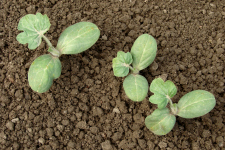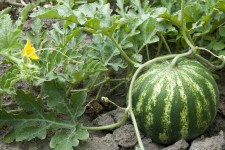Watermelon is one of Australia’s favourite fruits. There’s nothing more refreshing on a hot summer’s day than to be sitting outside with a big slice of watermelon letting the juice drip all over your chin and your arms.
Watermelons are so easy to grow that there’s no real need to buy them from the shops but they do need quite a lot of space because the vine will creep along the ground. The flowers are pollinated by bees that carry the pollen between each one. If this is successful, each vine will produce several melons which in the case of the round variety, could end up being about the size of a basketball and weigh between 3 and 5kg!
The large green leaves of the vine help to shade the melons and the soil underneath keeping them cool during the summer heat. The thick outside skin and white layer inside of the melon are not eaten but it’s the bright red flesh in the middle that is deliciously swee and loved by almost everyone.
PLANTING
Watermelon vines need a fair bit of space with each one covering an area that is about 100cm x 100cm. This could even be in the back corner of the garden, providing there is direct sunlight. Before planting, dig lots of compost through the soil and pile it up into mounds that are about 100cm wide by 20cm high. Water the mounds lightly and then plant one seedling into the middle of each mound and water them again. These mounds make sure that the roots of the plant are in rich soil that is well drained and, as the seedlings grow, the vines trail down the side of each one.
Although watermelons can be grown in very, very large containers such as an old bath, the vines will want to spill over the sides and onto the ground so make sure there is plenty of room around it. Choose a spot that gets at least 6 hours of direct sunlight and fill the container with premium potting mix or good quality soil mixed with compost. Depending on the size of the container, plant one or two seedlings in each one; a large bath could have two growing in it. Once the seedlings are planted, water the soil well.
CARE AND MAINTENANCE
Water the plants every day unless there has been a good amount of rain and apply a granular fertiliser around the vines when they start flowering, this will encourage more melons to grow.
Like pumpkins, watermelon flowers are fertilised by bees which fly from flower to flower. If there aren’t many bees in the area, it’s a good idea to get a little paint brush to collect the pollen from male flowers and brush it on to the blossom in the centre of the female flowers. The female flowers are the ones with a tiny little melon forming at the base. Once this has been done, little melons will start popping up from under the vine.
HARVESTING
Watermelons are ready to harvest when they are at least 20cm across and when the part touching the ground turns yellow. To be sure that it is ripe, knock on the melon with your knuckles and see if it sounds hollow. If it doesn’t leave it to grow for another week.
HOW TO EAT
Although watermelon is fantastic in fruit salads and slushies, it is most popular eaten in big slices by simply biting into it. However, it is a difficult fruit to cut up so always ask an adult to do this for you before you head outside to let the juices drip onto the grass.
Find great recipes in the Smarty Plants Kitchen.
HOW THEY GROW
A watermelon vine grows along the ground and has large leaves which help protect the fruit. The vine forms flowers which are pollinated by bees and other insects. These then form into the melon which gradually grows to the size of a basketball.
FAST FACTS
Botanical Name: Cucumis melo
Life Cycle: Annual
When to Grow: Spring through to autumn in most areas. Very cold areas should grow them in summer and tropical areas should grow melons in autumn and early winter.
Height/Width: The vine will spread to 100cm wide and grow 40cm high.
Requirements: Plant in full sun and water every day unless it rains. Apply extra fertiliser when planting the seedlings and again when the vine is flowering.
Nutritional Benefits: Great source of vitamin C as well as potassium which helps those people that eat too much salt.



